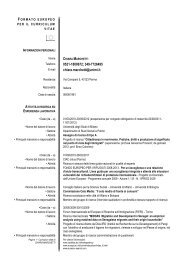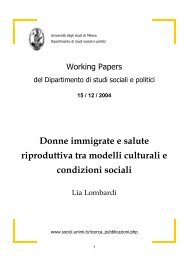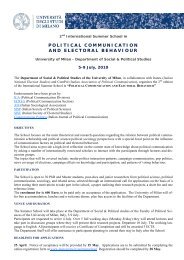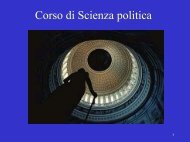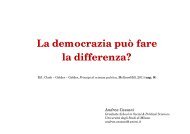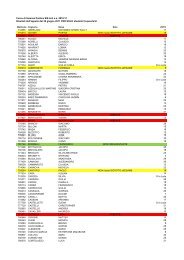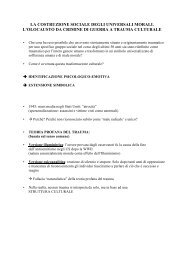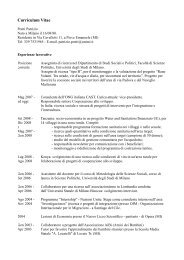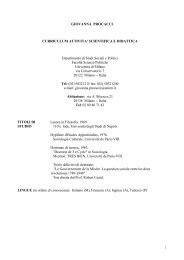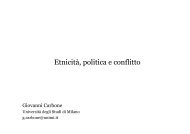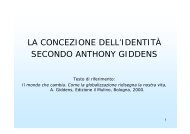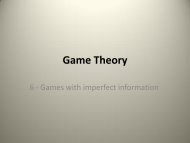The european dimension of political discourse in Italy. A ... - CIRCaP
The european dimension of political discourse in Italy. A ... - CIRCaP
The european dimension of political discourse in Italy. A ... - CIRCaP
You also want an ePaper? Increase the reach of your titles
YUMPU automatically turns print PDFs into web optimized ePapers that Google loves.
THE EUROPEAN DIMENSION OF POLITICAL DISCOURSE IN ITALY.<br />
<strong>of</strong> the parties <strong>in</strong> government can be expla<strong>in</strong>ed more <strong>in</strong> terms <strong>of</strong> elite adaptation to the use <strong>of</strong><br />
the foreign/European issues than as a sign <strong>of</strong> real attachment to the priorities that would be<br />
suggested by Europhilia.<br />
<strong>The</strong> conversion, <strong>in</strong> different times, <strong>of</strong> the two left parties brought the whole <strong>political</strong> elite to a<br />
fully pro-European mode, which was probably mark<strong>in</strong>g its most significant po<strong>in</strong>t dur<strong>in</strong>g the<br />
eighties. After Maastricht, the traditionally loyal, but not very specific, pro-European<br />
<strong>discourse</strong> <strong>of</strong> the Italian elite started develop<strong>in</strong>g <strong>in</strong> a more articulate cluster <strong>of</strong> positions,<br />
cover<strong>in</strong>g the different <strong>dimension</strong>s <strong>of</strong> the <strong>in</strong>tegration process and sometimes stress<strong>in</strong>g its<br />
negative consequences. In other words, the European issue becomes more problematic,<br />
be<strong>in</strong>g less and less l<strong>in</strong>ked to a given general image <strong>of</strong> the <strong>in</strong>ternational relations (or not<br />
useful anymore for reasons <strong>of</strong> <strong>in</strong>ternal legitimisation) but, at the same time, becom<strong>in</strong>g a<br />
comb<strong>in</strong>ation <strong>of</strong> several policy goals, whose implications are now seen by the <strong>political</strong> actors<br />
both <strong>in</strong> terms <strong>of</strong> costs and benefits.<br />
One can take the 1996 data from the first Top Decision Makers survey, conducted by EOS<br />
Gallup Europe for the European Commission, as the f<strong>in</strong>al po<strong>in</strong>t <strong>of</strong> such a long transformation<br />
(Spence 1996). <strong>The</strong>se data confirm, <strong>in</strong> fact, that the large majority <strong>of</strong> the Italian top decision<br />
makers (<strong>in</strong> particular, the politicians) th<strong>in</strong>k to European <strong>in</strong>tegration as a positive process<br />
br<strong>in</strong>g<strong>in</strong>g only benefits to the country, and they wish further improvements <strong>of</strong> the European<br />
Union, both <strong>in</strong> terms <strong>of</strong> enlargement and enforcement <strong>of</strong> the EU <strong>in</strong>stitutional framework. At<br />
the same time, the technocratic elite rul<strong>in</strong>g the country <strong>in</strong> the mid-n<strong>in</strong>eties 30 seem to have<br />
absorbed a number <strong>of</strong> concerns about the costs <strong>of</strong> <strong>in</strong>tegration and the necessity to pursue<br />
specific priorities <strong>in</strong> the build<strong>in</strong>g <strong>of</strong> the European Union.<br />
For <strong>in</strong>stance, the net difference between the elite support and the general public support to<br />
the s<strong>in</strong>gle currency is, <strong>in</strong> 1996, the lowest <strong>of</strong> the EU (10%, that is 88% - 78%). This figure has<br />
two mean<strong>in</strong>gs, both consistent with the historical trend: the first mean<strong>in</strong>g is the persistence <strong>of</strong><br />
trust <strong>in</strong> the European <strong>in</strong>stitutions among the Italian public op<strong>in</strong>ion (<strong>in</strong> fact, the general public<br />
support <strong>in</strong> the EU15 is only 53%). On the other hand, the elite support to the s<strong>in</strong>gle currency<br />
is <strong>in</strong> l<strong>in</strong>e with the EU15 trend (88% <strong>in</strong> <strong>Italy</strong>, 85% <strong>in</strong> the EU). In sum, before the Euro<br />
changeover, the perceptions <strong>of</strong> European <strong>in</strong>tegration <strong>of</strong> the Italian rul<strong>in</strong>g class is one <strong>of</strong> a<br />
stable “Euro-enthusiastic” elite, who has learned how to dist<strong>in</strong>guish the different connotations<br />
<strong>of</strong> this process. Two sentences from the Italian top decision makers <strong>in</strong>terviewed <strong>in</strong> the EOS<br />
30 We do not have <strong>in</strong>formation about the party backgrounds <strong>of</strong> the top decision makers <strong>in</strong>terviewed by<br />
EOS Gallup <strong>in</strong> 1996. Nevertheless, we suppose that the technocratic sector <strong>of</strong> such a sample is<br />
dom<strong>in</strong>ant: <strong>in</strong> fact, only 90 out <strong>of</strong> the 450 Italians <strong>in</strong>cluded <strong>in</strong> the sample were elected politicians.<br />
Moreover, this sub-group <strong>in</strong>cludes, accord<strong>in</strong>g to the notes <strong>of</strong> the report, even the members <strong>of</strong> the<br />
35



